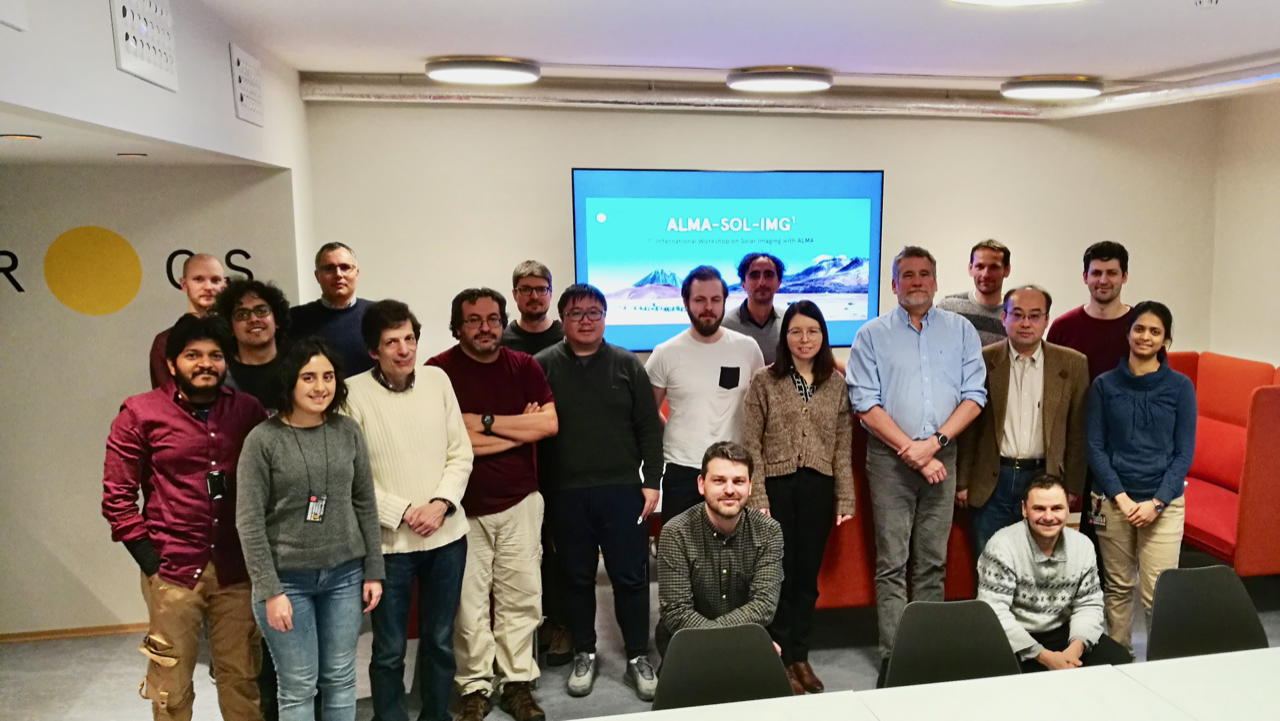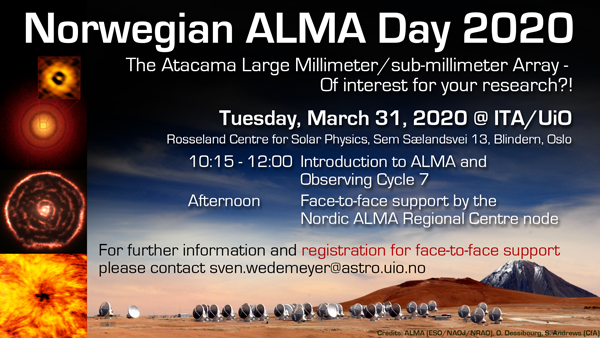In week 10 the 1st international Workshop on Solar Imaging with ALMA, "ALMA-SOL-IMG1" took place in the new premises of the Rosseland Centre for Solar Physics (RoCS).
Twenty-one participants from all involved regions from Europe (including the European Southern Observatory - ESO and RoCS), North America, East Asia and Chile gathered with the main aims to review the current status of processing ALMA observations of the Sun, identify the next steps for development and discuss solutions. Ten more participants joined the presentations and discussions via videoconferencing.
ALMA: 66 eyes to the Sun
-
The 66 antennae in the Atacama Desert of northern Chile were designed specifically to tolerate the Sun’s strong radiation, thus enabling to observe the Sun directly.
-
ALMA operates at millimeter and submillimeter wavelengths, from roughly 350 microns to (currently) 3.6 mm, filling in the gap between optical/infrared telescopes, and radio telescopes. In this "spectral window", the scientifically interesting chromosphere - an integral layer of the solar atmosphere - can be observed.
The Sun not a trivial target
Regular observations of the Sun with the Atacama Large Millimeter/sub-millimeter Array (ALMA) started in 2016. In the same year Sven Wedemeyer, associate professor at the Institute of Theoretical Astrophysics, got granted the prestigious Consolidator Grant by the European Research Council (ERC) for the project SolarALMA.
– Producing reliable images was a challenging task in the beginning, confesses Wedemeyer.
The 66 radio antennae are usually pointed towards galaxies, black holes and interstellar nebulae.
– The Sun is quite different from other astronomical targets. In particular, it varies on very short timescales. Integrating over longer times like it is routinely done for other ALMA targets such as, e.g., protoplanetary disks is not an option for solar observations, explains Wedemeyer.
Hands-on with SoAP
Computing image series of the Sun from the interferometric measurements requires extra work and development given the many technical challenges. This requires substantial efforts and combined expertise.
– Also the correct calibration, necessary for reliable brightness-temperature measurements, had to be discussed, adds Wedemeyer.
The most difficult obstacle to overcome in achieving scientific results from the ALMA solar data is the issue of image synthesis. At the workshop the international experts in interferometry and solar data analysis could work on selected ALMA observations using different approaches including the Solar ALMA Pipeline (SoAP) developed at RoCS for the production of images.

Currently ten people work in three ongoing projects focused on ALMA observations of the Sun (SolarAlma, Emissa, ESO ALMA Development Study - High-cadence imaging of the Sun) all supervised by Wedemeyer, and two additional RoCS postdoctoral fellows being interested in working with solar ALMA Data. RoCS plays an important role in the development of solar science with ALMA.
– RoCS was very happy that it could use the opportunity to host the first workshop in a most likely future annual workshop series, says excited Wedemeyer.
Next in line is the Norwegian ALMA day, March 31, 2020. Astrophysicists interested in observations with the Atacama Large Millimeter/sub-millimeter Array (ALMA) will receive support and explanations on ALMA's capabilities and application processes for observing time, all in one day!













